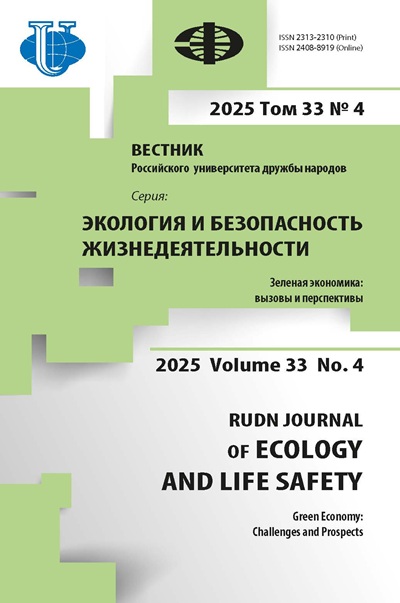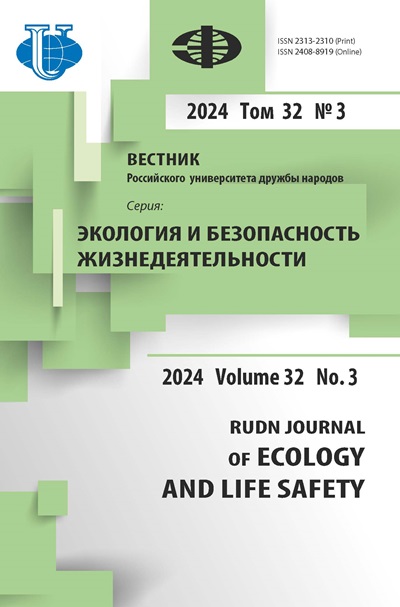Modification of the properties of nonconforming zeolite raw materials from deposits in Eastern Transbaikalia in order to obtain effective sorbents for wastewater treatment
- Authors: Obuzdina M.V.1, Rush E.A.2
-
Affiliations:
- State University of Education
- Irkutsk State Transport University
- Issue: Vol 32, No 3 (2024)
- Pages: 286-293
- Section: Industrial Ecology
- URL: https://journals.rudn.ru/ecology/article/view/41276
- DOI: https://doi.org/10.22363/2313-2310-2024-32-3-286-293
- EDN: https://elibrary.ru/ZPRHNG
- ID: 41276
Cite item
Abstract
The article presents the results of investigation of various modifications based on nonconforming zeolite raw materials rocks of the Holinsky depozit with a low klinoptilolite content (50-55%), which substantiates the feasibility of their involvement in the production of sorbents effective for wastewater treatment from oil products and heavy metal ions. Various methods of modifying zeolites have been studied: with high-silicon compounds (hexamethyldisilazalone and tetraethoxysilane), as well as with a sulfur polymer based on by-products of the production of epichlorohydrin. The investigation of microstructures of obtained samples was carried out using scanning electron spectroscopy (SEM), X-ray phase analysis (XPA) using powder X-ray diffractometry. The fixation of modifiers on the zeolite surface has been proven by IR spectroscopy and energy-dispersive X-ray spectroscopy (EDS). The sorption of heavy metal ions such as nickel and zinc on modified zeolites has been proven by IR, EDS, and inductively coupled plasma atomic emission spectrometry (ICP-AES). To prove the sorption of oil products, IR methods were used, as well as differential scanning calorimetry and thermogravimetry. Сlass of hazard (IV) for spent sorbents was established by biotesting using Daphnia magna Straus and Chlorella vulgaris Beijer .
Full Text
Introduction Mining is the largest consumer of mineral resources, and the large amount of waste generated has a negative impact on all aspects of the environment: atmosphere, hydrosphere, lithosphere. When developing a mineral deposit, simultaneously with useful components, a substantial amount of waste or nonconforming rocks is extracted, which are stored by open-pit method in the adjacent territory, being objects of negative impact on the ecosystems of the area of placement. [1, 2]. In the mining industry, standard zeolite raw materials are counted as tuffs with a klinoptilolite (KPT) content of 70% or more. In this way they can be used in medicine, agriculture, for the production of heat-insulating materials, etc. Most of the zeolite tuffs of the Eastern Zabaikalya Holinsky deposit have insufficient level of klinoptilolite (50-55)%, which justifies the inclusion of this raw material in other products [3]. The aim of the work is to study the composition and properties of non-conforming zeolit-containing rocks of the type of Holinsky Deposit (NZR) for production of sorbents, efficient for extraction of ions of heavy metals and oil from industrial waste water from railway transport and mining and metallurgy enterprises. Materials and methods NZR are layered silikats with a crystal lattice in the form of tetrahedron [Al, Si]O4 which are packed quite loose. The voids between them are filled with water which can be removed and further replaced by waste water pollutants [4]. Natural zeolites as micro-porous sorbents are characterized by such physical parameters as true and ap-parent density, bulk density, and porosity. The micro-pore size of zeolites 5 - 15 Å allows to sorb petroleum products (2 - 30 Å) by means of an advanced specific surface, and heavy metal ions, as for example, the radius of the atom Ni is 124 pm, Cu - 126 pm, Zn - 138 pm, Fe - 126 pm, Cr - 130 pm (1 pycometer = 0.01 Å). Textural and geometrical properties of NZR showing a high porousity - 40.87% with an average pore radius (in volume) - 0.362 μm and a micropore surface - 6.21 μm. Bulk density 1006 - 779 kg/m3. Dimensions of the input apertures are (3-13) Ǻ. Diameters of the pores are not more than 10 Ǻ [5]. High-silica organic compounds [(CH3)3Si-]2NH hexamethyldilylasan (ZKGS) and (C2H5O)4Si tetraethoethoxysilane (ZKТS) are proposed as modifiers to improve the adsorption characteristics of the NZR. Sample preheating at 350 ºC is recommended to remove water, co-ordinate-related to exchange cations and oxygen framework and microcapillary release to increase the sample’s porosity. Also the sulphur polymer on the base of 1,2,3- trichlorophane, which is waste from the production of epichlorohydrin (ZKsul) was pro-posed as a modifier. This type of modification also leads to a partial hydrofobization of the surface to im-prove sorption properties of the source NZR, and insoluble sulphides are produced when the ion-free metals are treated in waste water. According to powder X-ray diffractometry (Figure 1) the NZR has the following phase composition: CPT→ Ca-Na field spat (plahyoclaz) → smectites → α-quartz. According to the RFA, the content of CPT in the tuff is 52 wt. %. The results obtained from an X-ray phase analysis of the ZKsul on the DRON 3.0 (Figure 1) show that the NZR is related to the CPT groups (52% wt. %.) and the heulandite. The phase composition is characterized by the presence of CPTNa6[(AlO2)6•(SiO2)40]•24H2О (9.02; 7.93; 6.81; 5.12; 4.24; 7.01; 3.42; 2.97; 2.79 Å), plagioclase (Ca, Na)(Al, Si) AlSi2O8 (5.25; 3.59; 2.77; 2.43 Å) and quartz SiO2 (4.24; 3.17 Å). Modification by the proposed methods does not cause significant changes in the initial phase composition of NZR, which justifies the possibility of cycles «sorption-desorption» up to 6-7 times. The microstructure of samples is studied by scanning electronic spectroscopy (SES) and X-ray phase analysis using powder X-ray diffractometry. The nature of fixing modifiers on the surface of zeolite is studied by IR-spectroscopy, energy-spectral x-ray spectroscopy, atomic emission spectrometry with induction-related plasma (AES-IRP). The IR, differential scanning calorimetry and thermogravimetric methods were used to prove the sorption of oil products [6]. а Дифрактограмма.bmp b Figure 1. Diffractogram of nonconforming zeolite raw materials (a) and sulfurpolymer modified zeolite (b): KПT - klinoptilolite (KPT); ПЗ - plagioclase; КЦ - α-quartz Source: compiled by the authors. Results of the study and discussion Elemental analysis of samples from ZKGS, ZKТS, ZKsul confirmed by SES on a two-ray scanning electron microscope JSM-6490LV with micro-analysis system -energy-efficiency x-ray spectrometer INCA Energy, X-max and INCA Wave VDC in the microlaboratory and nano-studies of DVGI DRF RAS (Table 1). The ZKsul example shows the presence of sulfur in the composition of adsorbent, confirming the fixing of the modifier on the surface. Figure 2 shows energy-dispersive X-ray spectra of samples studied. In the previously published research results [7], the IR spectra of ZKGS, ZKТS, ZKsul were analyzed to prove the fixation of modifiers on the surface of NZR, which are characterized by the appearance of new absorption band. Adsorbed metal ions interact with the structural lattice, fixing on the sorbent surface or in cavities, and Me-OH bonds are formed. During adsorption of oil products and heavy metal ions, a shift of some absorption bands to high-frequency regions is observed [8]. pulse / sec / electronvolt kiloelectronvolt a b c Figure 2. Energy dispersive X-ray spectrumsof ZKGS(а), ZKТS(b), ZKsul(c) Source: compiled by the authors. Table 1. Elemental analysis results for samples ZKGS, ZKТS, ZKsul. Adsorbent Elements O Al Si S K Ca Ti Fe ZKGS 49.41 7.76 35.81 - 5.04 0.94 - 1.05 ZKТS 50.64 6.56 38.20 - 2.63 1.57 - 0.41 ZKsul 49.06 6.5 34.87 0.51 5.19 1.87 1.17 0.83 Al2O3 SiO2 SO3 K2O CaO TiO2 FeO ZKGS 14.67 76.6 - 6.07 1.31 - 1.35 ZKТS 12.40 81.72 - 3.17 2.19 - 0.53 ZKsul 12.25 74.63 1.23 6.28 2.59 1.93 1.07 Source: compiled by the authors. In continuation of studies by ICP-AES method on spectrometer iCAP 7600 Duo adsorption and desorption of Ni2+, Zn2+ by sorbent ZKGS (Table 2). The data of Table 2 indicate high sorption activity of the studied sample in relation to heavy metal ions. Synchronous thermo-analysis of ZKGS and ZKТS after adsorption of oil products was carried out on the STA 449 F1 Jupiter equipment of NETZSCH company (Germany) in IPREC SB RAS (Figure 3). The thermograms of all samples on the TG-curve show a smooth, without pronounced steps, course of mass loss associated with dehydration of zeolites and characteristic of unconditioned zeolite-like rocks of the Holinsky deposit [9]. The DTG curve shows an endothermic peak associated with water yield from the sample at the initial stage of heating, which is characterized by an end-peak at 134.2 °C. The second less pronounced end-peak with an extremum at 475.5 °C is associated with the yield of hydroxyl water. On the DSC-curve endopic at 180 °C characterizes the rate of mass loss, associated with the yield of petroleum products. Table 2. Results of determining the content of elements in ZKGS samples after adsorption and desorption of Ni2+, Zn2+ (g/t) by ICP-AES Ions ZKGS Ba Cr Cu Li Sc Sr V Ni Zn Ni2+ After adsorption 111.4 1.83 11.12 6.17 1.5 47.5 2.93 397 - After desorptions 93.2 1.24 4.9 5.5 1.3 39 2.8 72 - Zn2+ After adsorption 163.3 4.11 3.42 8.2 1.6 54.6 2.4 - 482 After desorptions 58.52 0.342 1.664 4.73 1.1 23.9 1.4 - 166 Temperature, (grad)C Figure 3. Thermogram of ZKТS after adsorption of oil products Source: compiled by the authors. Conclusions A complex approach of utilization of nonconfirming zeolite raw materials of clinoptilolite type into various sorbents for wastewater treatment from oil products and heavy metal ions: ZKGS, ZKТS, ZKsil was proposed. Various methods of analysis proved the fixation of modifiers on the surface of adsorbents. Fixation of modifiers on the zeolite surface was proved by IR spectroscopy and energy-dispersive X-ray spectroscopy. The results of atomic emission spectrometry with inductively coupled plasma proved sorption of heavy metal ions on modified zeolites. Infrared spectra, thermo-grams show adsorption of petroleum products on ZKGS, ZKТS.About the authors
Marina V. Obuzdina
State University of Education
Author for correspondence.
Email: obuzdina_mv@mail.ru
ORCID iD: 0000-0002-4956-0063
SPIN-code: 2400-3128
Candidate of Technical Sciences, Assistant Professor, Director of the Scientific and Educational Center of the Faculty of Life Safety
24 Vera Voloshina St, Mytishchi, 141014, Russian FederationElena A. Rush
Irkutsk State Transport University
Email: lrush@mail.ru
SPIN-code: 7207-1065
Doctor of Engineering Sciences, Professor, Heard of Academy Department “Technosphere Safety” 15 Chernyshevsky St, Irkutsk, 664074, Russian Federation
References
- Komashchenko VI, Golik VI, Drebenstedt KK. Impact of geological exploration and mining activities on the environment. Moscow: KDU Publishing House; 2010 (In Russ.)
- Teckentrup, L, Kramer-Schadt S, Jeltsch F. The risk of ignoring fear: underestimating the effects of habitat loss and fragmentation on biodiversity. Landscape Ecology. 2019;(34)12:2851-2868.
- Khatkova, AN, Razmakhnin KK. Zeolite-containing rocks of Eastern Transbaikalia: new processing technologies. Bulletin of the Institute of Geology of the Komi Scientific Center of the Ural Branch of the Russian Academy of Science. 2016;(1):30-33 (In Russ.)
- Greg S, Singh K. Adsorption, specific surface area, porosity. Moscow: Mir; 1987. (In Russ.)
- Chelishchev NF. Zeolites are a new type of mineral raw material. Moscow: Nedra; 1987 (In Russ.)
- Pentin YuA, Vilkov LV. Physical research methods in chemistry. Moscow: Mir-Art; 2003 (In Russ.)
- Obuzdina MV, Rush EA. Investigation of the features of the interaction of pollutant components of industrial wastewater with modified zeolites based on the results of comprehensive physical and chemical investigations. Ecology and industry of Russia. 202;(25)3:36-40 (In Russ.)
- Böcker Y. Spectroscopy. Moscow: Technosphere; 2009 (In Russ.)
- Yusupov TS, Shumskaya LG. Mechanochemical processes in zeolite-phosphate systems. Chemistry for sustainable development. 2007;(15)2:229-234 (In Russ.)
Supplementary files















